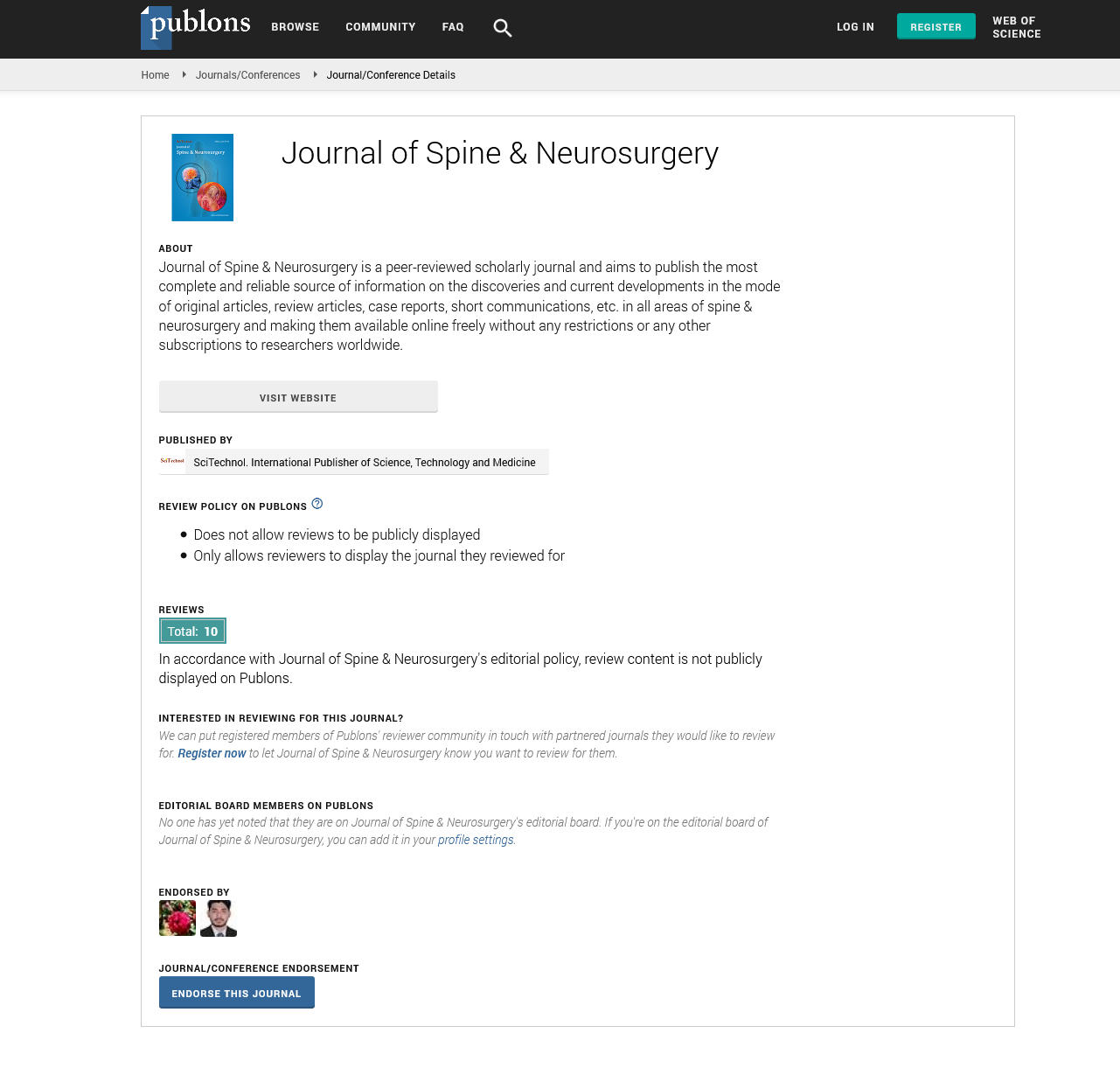Perspective, J Spine Neurosurg Vol: 13 Issue: 4
Transforming Lives: The Role of Lumbar Spine Surgery in Pain Management
Charles Franke*
1Department of Orthopedic Surgery, Niigata Medical University of Orthopedic Sciences, Niigata, Japan
*Corresponding Author: Charles Franke,
Department of Orthopedic Surgery,
Niigata Medical University of Orthopedic Sciences Niigata, Japan
E-mail: charles.franke7890@gmail.com
Received date: 27 July, 2024, Manuscript No. JSNS-24-152428;
Editor assigned date: 30 July, 2024, PreQC No. JSNS-24-152428 (PQ);
Reviewed date: 12 August, 2024, QC No. JSNS-24-152428;
Revised date: 19 August, 2024, Manuscript No. JSNS-24-152428 (R);
Published date: 29 August, 2024, DOI: 10.4172/2325-9701.1000221.
Citation: Franke C (2024) Transforming Lives: The Role of Lumbar Spine Surgery in Pain Management. J Spine Neurosurg 13:2.
Description
Lumbar spine surgery is a essential intervention for addressing a variety of spinal disorders that can severely affect patients' quality of life. Conditions such as herniated discs, spinal stenosis and the patient degenerative disc disease can lead to significant pain, mobility issues and neurological deficits. Over the years, lumbar spine surgery has evolved to include both traditional open procedures and minimally invasive techniques, providing effective relief while minimizing recovery times. This article examines the indications for lumbar spine surgery, the surgical techniques used, postoperative care and expected outcomes.
Indications for surgery
The decision to pursue lumbar spine surgery is often based on a combination of clinical symptoms, imaging findings and the failure of conservative treatments. Herniated discs, where the disc material bulges and compresses nearby nerves, often lead to debilitating pain and neurological symptoms. When conservative treatments such as physical therapy, medications and injections fail to relieve these spinal symptoms, surgical intervention may be necessary.
Spinal stenosis, characterized by the narrowing of the spinal canal, can also compress spinal nerves and cause pain, numbness and patient is difficulty walking. Surgery may be indicated to alleviate these symptoms. Degenerative disc disease, a condition where discs lose hydration and elasticity over time, can result in instability and pain, prompting the need for surgical stabilization. Another indication is spondylolisthesis, which occurs when one vertebra slips over another, potentially compressing nerves and causing discomfort. The decision for surgery is typically made after a thorough evaluation by a spine specialist, who considers the severity of the condition, the patient's overall health and the potential risks and benefits of the procedure.
Surgical techniques
Lumbar spine surgery can be broadly categorized into traditional open surgery and minimally invasive techniques, each with its distinct advantages and challenges. Traditional open surgery involves a larger incision to access the spine directly, allowing for a comprehensive view of the surgical site. Common procedures include lumbar discectomy, laminectomy and spinal fusion. While these methods can effectively address complex spinal issues, they often involve longer recovery times and greater postoperative pain.
Minimally invasive surgery has gained popularity due to its potential benefits, including reduced tissue damage, shorter hospital stays and quicker recovery. Techniques such as microdiscectomy and endoscopic lumbar surgery utilize smaller incisions and specialized instruments to minimize disruption to surrounding tissues. In cases where spinal instability is present, spinal fusion may be performed alongside decompression, using methods like anterior lumbar interbody fusion or posterior lumbar fusion to stabilize the affected segments. Additionally, robotic-assisted surgery is emerging as a promising option, enhancing precision in screw placement and potentially improving surgical outcomes.
Conclusion
In conclusion, lumbar spine surgery plays a important role in transforming the lives of individuals suffering from debilitating pain. By effectively addressing underlying spinal issues, this surgical intervention not only alleviates discomfort but also restores mobility and enhances overall quality of life. As advancements in techniques and technology continue to improve outcomes, lumbar spine surgery remains an essential component of modern pain management strategies, offering hope and renewed functionality to those who may have previously felt limited by their conditions. Ultimately, the success of these procedures highlights the importance of a multidisciplinary approach to spinal health, ensuring that patients receive comprehensive care tailored to their unique needs.
 Spanish
Spanish  Chinese
Chinese  Russian
Russian  German
German  French
French  Japanese
Japanese  Portuguese
Portuguese  Hindi
Hindi 
